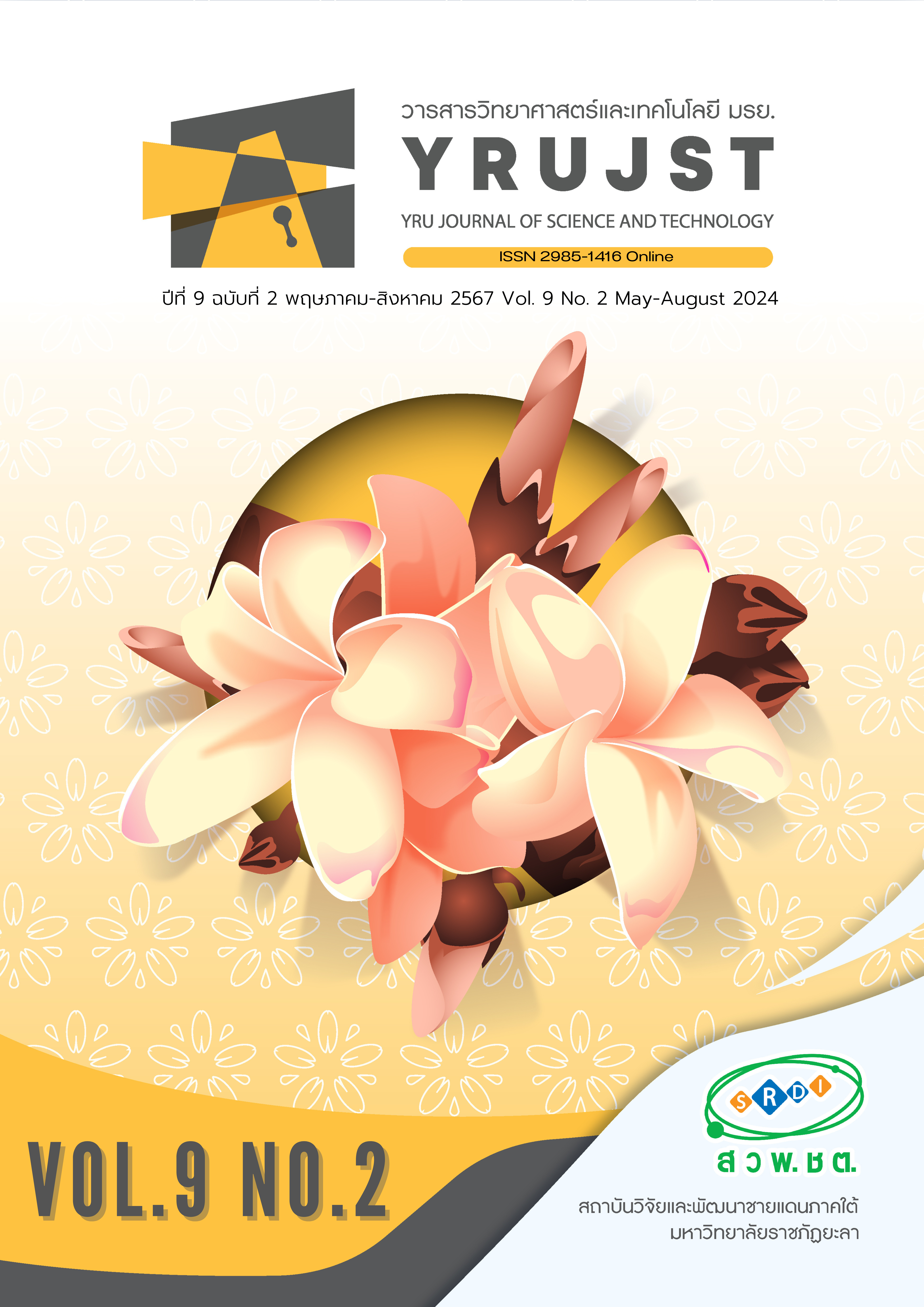ผลของกระบวนการผลิตต่อคุณภาพของผงผักเชียงดา และการยกระดับคุณภาพผลิตภัณฑ์ชาผักเชียงดาผสมสมุนไพรของวิสาหกิจชุมชนศูนย์ศึกษาการพัฒนาภูพาน อำเภอปลาปาก จังหวัดนครพนม
Main Article Content
บทคัดย่อ
ชาผักเชียงดาผสมสมุนไพร เป็นผลิตภัณฑ์ของวิสาหกิจชุมชนศูนย์ศึกษาการพัฒนาภูพาน มีปัญหาในเรื่องของกระบวนการผลิตและคุณภาพของผลิตภัณฑ์ งานวิจัยนี้มีวัตถุประสงค์เพื่อศึกษาผลของกระบวนการผลิตต่อคุณภาพของผงผักเชียงดาและการยกระดับคุณภาพผลิตภัณฑ์ชาผักเชียงดาผสมสมุนไพร โดยศึกษาเปรียบเทียบกระบวนการผลิต 3 วิธี ได้แก่ วิธีที่ 1 อบอุณหภูมิ 50 องศาเซลเซียส นาน 240 นาที วิธีที่ 2 ลวกอุณหภูมิ 90 องศาเซลเซียส 30 วินาที แล้วอบอุณหภูมิ 50 องศาเซลเซียส นาน 240 นาที และวิธีที่ 3 ลวกอุณหภูมิ 90 องศาเซลเซียส 30 วินาที คั่วนาน 10 นาที แล้วนำไปอบอุณหภูมิ 50 องศาเซลเซียส นาน 240 นาที ผลการศึกษาพบว่าการทำแห้งด้วยการลวกก่อนนำไปอบจะทำให้ได้ผงผักเชียงดาที่มีสีเขียวสดและไม่คล้ำ โดยมีค่าความสว่าง (L*) ค่าความเป็นสีเขียว (-a*) และค่าความเป็นสีเหลือง (b*) สูงสุด ปริมาณสารประกอบฟีนอลิกทั้งหมดอยู่ที่ 68.27 มิลลิกรัมสมมูลของกรดแกลลิกต่อกรัมของตัวอย่างแห้ง และฤทธิ์ในการต้านอนุมูลอิสระโดยวิธี DPPH radical scavenging activity ที่ร้อยละ 24.06 เมื่อนำผงผักเชียงดาที่ผลิตได้ไปผลิตเป็นผลิตภัณฑ์ชาผักเชียงดาผสมสมุนไพร ผลิตภัณฑ์ที่ได้มีค่าปริมาณความชื้น ค่าปริมาณเชื้อจุลินทรีย์ทั้งหมด ยีสต์และราเป็นไปตามมาตรฐานผลิตภัณฑ์ชุมชน มีปริมาณสารประกอบฟีนอลิกทั้งหมด 44.13 มิลลิกรัมสมมูลของกรดแกลลิกต่อกรัมของตัวอย่างแห้ง และฤทธิ์ในการต้านอนุมูลอิสระที่ร้อยละ 24.02 ดังนั้น กระบวนการผลิตผงผักเชียงดาโดยใช้การลวกอุณหภูมิ 90 องศาเซลเซียส เป็นเวลา 30 วินาที และอบอุณหภูมิ 50 องศาเซลเซียส นาน 240 นาที เป็นวิธีการที่เหมาะสม
Article Details

อนุญาตภายใต้เงื่อนไข Creative Commons Attribution-NonCommercial-NoDerivatives 4.0 International License.
บทความ ข้อมูล เนื้อหา รูปภาพ ฯลฯ ที่ได้รับการเผยแพร่ในวารสารวิทยาศาสตร์และเทคโนโลยี มรย. นี้ ถือเป็นลิขสิทธิ์ของวารสารวิทยาศาสตร์และเทคโนโลยี มรย. หากบุคคลหรือหน่วยงานใดต้องการนำทั้งหมดหรือส่วนหนึ่งส่วนใดไปเผยแพร่ต่อหรือกระทำการใดๆ จะต้องได้รับอนุญาตเป็นลายลักษณ์อักษรจากวารสารวิทยาศาสตร์และเทคโนโลยี มรย. ก่อนเท่านั้น
เอกสารอ้างอิง
AOAC. (2005). Official Methods of Analysis (18th ed.). Maryland: AOAC International.
Aummarin, N. & Aummarin, S. (2019). Product development of Thai Copper Pod flower with Chrysanthemum flower tea. Vocational Education Central Region Journal, 3(1), 71-78.
Chinnasarn, S. & Krasaechol, N. (2020). Effect of pretreatment and drying conditions on quality of dried green caviar product. The Journal of King Mongkut's University of Technology North Bangkok, 30(4), 668-677. (in Thai).
Jeytawan, N., Yadoung, S., Jeeno, P., Yana, P., Sutan, K., Naksen, W., Wongkaew, M., Rose Sommano, S. & Hongsibsong, S. (2022). Antioxidant and phytochemical potential and phytochemicals in Gymnema inodorum (Lour.) Decne in Northern Thailand. Plants, 11(24), 3498.
Kaewka, K., Kubglomsong, S. & Arsa, S. (2021). The effects of drying and steeping conditions on phenolic contents and antioxidant activities of lotus petal tea. Journal of Food Technology, Siam University, 16(1), 78-88. (in Thai).
Kim, M. H., Kim, J. M. & Yoon, K. Y. (2013). Effects of blanching on antioxidant activity and total phenolic content according to type of medicinal plants. Food Science. Biotechnology, 22(3), 817-823.
Pandey, A. K. & Yadav, S. (2010). Variation in gymnemic acid content and non-destructive harvesting of Gymnema sylvestre (Gudmar). Pharmacognosy Research, 2(5), 309–312.
Pichairat, D. & Mahea, N. (2014). Effect of blanching on the phenolic content and antioxidant capacities of some Southern Thai indigenous vegetable. RMUTSV Research Journal, 6(2), 36-46. (in Thai).
Przeor, M., Flaczyk E., Beszterda, M., Szymandera-Buszka, K.E., Piechocka, J., Kmiecik, D., et al. (2019). Air-drying temperature changes the content of the phenolic acids and flavonols in white mulberry (Morus alba L.) leaves. Ciencia Rural, 49(11), 1-4.
Pokorn, J., and Schmidt, S. (2001). Effects of processing and storage on antioxidant efficacy in foods. Cambridge: Woodhead Publishing.
Sawaengkhot, W., Prommakool, A., Savedboworn, W. & Pattayakorn, K. (2018). Determination of phenolic compound and antioxidant activity in leaves of 2 mulberry (Morus alba L.) cultivar. KKU Science Journal, 46(Suppl), 359-362. (in Thai)
Shenoy, R. S., Prashanth, K. V. H. & Manonmani, H. K. (2018). In vitro antidiabetic effects of isolated triterpene glycoside fraction from Gymnema sylvestre. Hindawi, 2018(-), 1-12. https://doi.org/10.1155/2018/7154702.
Sirijariyawat, A., Polviluy, C. & Yalai, K. (2017). Effect of drying methods on physical property of spring onion. KKU Science Journal, 45 (Suppl), 1155-1161. (in Thai)
Thai Industrial Standards Institute (2013) Thai community product standard, Dried gymnema for infusion 1466/2556. (in Thai)
Thakur, G.S., Sharma, R., Sanodiya, B. S., Pandey, M., Prasad, G. & Bisen, P.S. (2012). Gymnema sylvestre: An alternative therapeutic agent for management of diabetes. Journal of Applied Pharmaceutical Science, 2(12), 001-006.
Thepkorn, T. (2014). Tea. (1st ed.). Bangkok: Chulalongkorn University Press. (in Thai).
Von Elbe, J. H. & Schwartz, S. J. (1996). Colorants in food chemistry (3rd ed.). New York: Marcel Dekker, Inc.
Upadhya, V., Pai, S. R. & Hegde, H. V. (2015). Effect of method and time of extraction on total phenolic content in comparison with antioxidant activities in different parts of Achyranthes aspera. Journal of King Saud University–Science, 27, 204-208.
USFDA. (2014). Water Activity (aw) in Foods [Online]. Retrieved August 13, 2021, from: https://www.fda.gov.
Yingthongchai, P., Sirikhum, P., Nilsamranchit, S. & Tateing, S. (2018). Comparison of nutritional value and bioactive compounds in Gymnema inodorum Decne. leaves. Journal of Agriculture, 34(3), 363-372. (in Thai)


